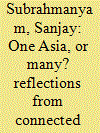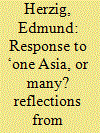|
|
|
Sort Order |
|
|
|
Items / Page
|
|
|
|
|
|
|
| Srl | Item |
| 1 |
ID:
144212


|
|
|
|
|
| Summary/Abstract |
In recent years people have been saying that the next century will be the century of Asia and the Pacific, as if that were sure to be the case. I disagree with this view. If we exclude the United States, the only countries in the Asia-Pacific region that are relatively developed are Japan, the ‘four little dragons’, Australia and New Zealand, with a total population of at most 200 million. (. . .) But the population of China and India adds up to 1.8 billion. Unless those two countries are developed, there will be no Asian century. No genuine Asia-Pacific century or Asian century can come until China, India and other neighbouring countries are developed. By the same token, there could be no Latin-American century without a developed Brazil. We should therefore regard the problem of development as one that concerns all mankind and study and solve it on that level. Only thus will we recognize that it is the responsibility not just of the developing countries but also of the developed countries.
|
|
|
|
|
|
|
|
|
|
|
|
|
|
|
|
| 2 |
ID:
144213


|
|
|
|
|
| Summary/Abstract |
The idea of Asia as a unity has appealed both to Europeans interested in differentiating themselves from a threatening, if inferior, Asiatic ‘other’, and to Asians keen to mark their distance from an alien and alienating Europe and West. For both groups, Asia is a useful term of alterity, although the place of ‘us’ and ‘them’ is reversed. Near the beginning of his lecture Sanjay Subrahmanyam remarks that, ‘in the play between the -emic and the -etic, the insider's and the outsider's perspective, a concept like “Asia” falls decidedly on the side of the -etic’. This point is reinforced by the fact that the European concept of Asia goes back to the Ancient Greeks (as Subrahmanyam notes), whereas the interest of Asian insiders in the concept of a homogeneous Asia is a modern phenomenon, a reaction against the assumption of superiority inherent in Western imperialism and neo-imperialism. In the case of both the European and the Asian conceptions, however, it is the viewpoint of the observer, rather than the empirical features of what is observed, that gives shape and meaning to the concept. I will use this short response to take a look at Asia from a third perspective, one that is neither fully ‘insider’ nor ‘outsider’ in character, namely that of the early modern Armenians, whose travels took them across the length and breadth of Asia, and Europe too.
|
|
|
|
|
|
|
|
|
|
|
|
|
|
|
|
|
|
|
|
|